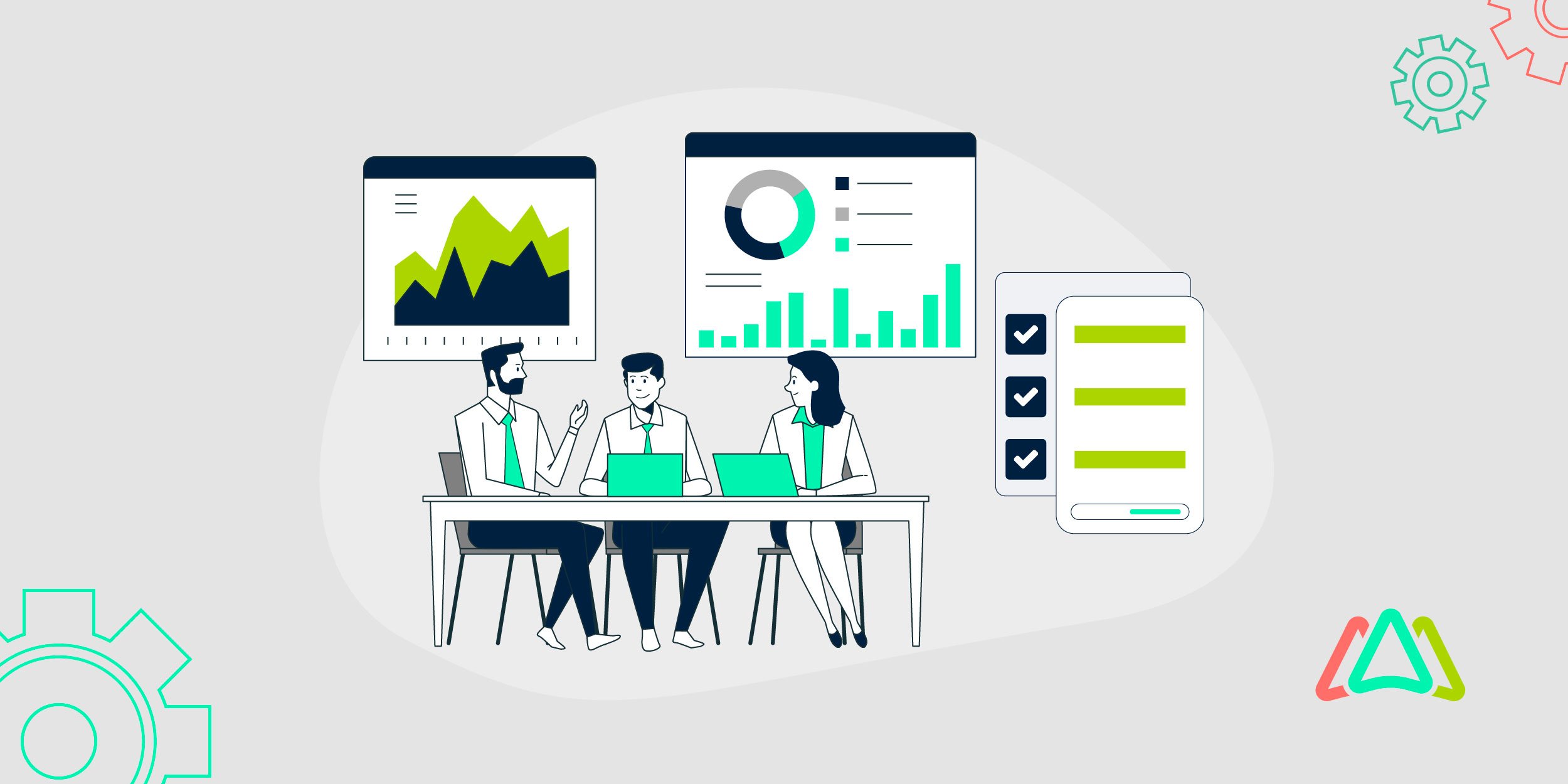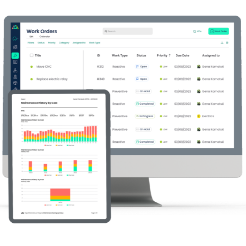
Must Have Features for Enterprise CMMS Software
Downtime in enterprise environments doesn’t just mean a stop in operations; it means lost revenue, delayed orders, unhappy customers, and higher repair costs. Disorganized maintenance fuels the fire, leading to reactive repairs, wasted labor, and unplanned outages that ruin productivity.
Organizations rely on a powerful tool like the Computerized Maintenance Management System (CMMS) to bring order to the complexity of enterprise maintenance. More than just a digital logbook, a CMMS Software enables teams to plan, execute, and analyze maintenance activities precisely. It serves as the operational backbone for achieving maintenance excellence. However, only a purpose-built CMMS can handle the scale and sophistication required at the enterprise level.
Choosing the right enterprise CMMS software is crucial for large organizations that manage hundreds of assets, facilities, and teams across multiple locations. It’s not just about logging work orders; it’s about enabling data-driven decisions, ensuring compliance, reducing downtime, and seamlessly integrating with enterprise systems.
This article will discuss the must-have features every enterprise should demand from a CMMS. Features that go beyond the basics, delivering enterprise-level performance, scalability, and intelligence. If you're evaluating systems or upgrading your current solution, this checklist is for you.
Why Enterprises Need Specialized CMMS Software
While small businesses might get by with spreadsheets or entry-level maintenance tools, enterprises operate on a completely different scale. With hundreds or even thousands of assets, locations, and users, the tolerance for error is zero, and the need for automation, visibility, and control grows exponentially. Let’s explore why only a specialized enterprise CMMS can overcome that challenge:
1. Scale, Complexity, and Compliance
Enterprise maintenance teams must manage complex asset hierarchies, regulatory requirements, and multiple facility maintenance schedules to ensure optimal performance. They must also comply with industry standards, such as ISO, OSHA, and FDA , among others. You can’t settle for any old CMMS; enterprise-level tools must provide a scalable architecture, allow for customization, support custom workflows, and offer robust reporting.
2. Integration with Enterprise Tools
Modern enterprises rely heavily on interconnected systems, such as ERP for finance, EAM for meticulous asset management, and BMS for building automation. Enterprise CMMS software must integrate smoothly with various existing platforms, providing a unified operational view across multiple systems. This prevents isolated data pools and facilitates forward-thinking maintenance strategies that effectively cut across multiple functional areas.
3. Data Security and Role-Based Access
Security is also essential, as all departments, vendors, and professionals come and go through the system. An enterprise CMMS software needs to provide role-based permissions and audit trails, ensuring that sensitive maintenance and asset data are kept in a secure cloud infrastructure. Without that, companies are open to both operational and cyber failures.
Core Must-Have Features of Enterprise CMMS Software
1. Work Order Management System
Work orders are the backbone of any effective Computerized Maintenance Management System (CMMS). For production environments, tasks can be auto-scheduled based on the condition of assets, runtime, or calendar units. It must allocate work dynamically based on the technician’s role, skills, and availability to minimize delays and optimize resolution time. More importantly, field workers require seamless mobile access to receive work orders, log updates, upload images, and capture job signatures without leaving their device, all to keep that maintenance train moving along.
2. Asset Management
Advanced asset insights from enterprise CMMS software are a prerequisite. This software enables the tagging and structuring of assets within a well-defined hierarchy, ranging from buildings to individual sub-components.
Asset lifecycle management within enterprise CMMS software extends beyond basic tracking, providing thorough insight into each asset's condition and maintenance history. By hierarchically structuring assets and capturing relevant lifecycle data, such as depreciation, organizations can make informed decisions about repairing, upgrading, or retiring equipment. Such keen insight significantly reduces risk and improves utilization while maximizing long-term value across various fleet facilities and sundry equipment.
3. Preventive Maintenance Scheduling
Preventive maintenance drastically reduces unplanned failures, and enterprise systems require sophisticated scheduling tools that go beyond basic reminders. A good CMMS offers calendar-based and usage-based triggers, ensuring maintenance is performed on an exact schedule. Auto-generation of PM tasks occurs seamlessly, integrating them effectively into the workloads of various technicians every single time.
4. Predictive Maintenance Compatibility
As enterprises embrace predictive maintenance, CMMS software must evolve. Compatibility with IoT sensors enables the system to collect real-time data on equipment conditions, including vibration, temperature, and pressure. With condition-based monitoring, maintenance can be performed only when needed, saving time and resources.
5. Multi-site and Multi-user Capability
Many companies are cross-functional, with different teams. A strong enterprise CMMS solution must feature a central dashboard that allows you to see everything happening at your sites. It needs to provide robust user permission capabilities to ensure that the appropriate people are granted access to the relevant data. Reporting needs to be flexible, with site-specific information that can be aggregated to provide organization-wide insights for informed decision-making at the head office.
6. Inventory and Spare Parts Management
A well-functioning maintenance operation depends on the availability of the right parts at the right time. Enterprise CMMS software must track inventory in real time across all locations, send low-stock alerts before shortages occur, and simplify the reordering process. Integration with vendor systems further streamlines procurement, ensuring that parts are always on hand without overstocking.
7. Purchase Order and Vendor Management
Uncoordinated procurement cycles can cause bottlenecks. Purchasing: With a built-in purchase order, business users can create, approve, and track orders directly within the CMMS. All vendor performance, cost, and service history is stored in a central vendor database. For financial clarity and synchronization, the CMMS system must be compatible with the company’s Enterprise Resource Planning (ERP) systems.
8. Mobile Accessibility and Offline Mode
Modern maintenance teams are no longer tied to desks. They work across facilities, often in remote or signal-challenged environments. That’s why mobile access is no longer optional; it’s essential. Enterprise CMMS software should provide real-time updates, barcode scanning for assets and parts, and offline functionality that allows technicians to continue working even when internet access is unavailable. Once reconnected, all data should sync automatically.
9. Reporting and Custom Dashboards
Data is a core asset in maintenance management. Enterprise CMMS tools should deliver real-time KPIs such as Mean Time to Repair (MTTR), Mean Time Between Failures (MTBF), and compliance tracking. Custom dashboards must be available for different roles; executives need high-level overviews while technicians need task-focused views. All reports should be exportable and audit-ready, supporting operational insight and regulatory requirements.
10. Integration and API Access

No enterprise tool operates in isolation. A modern CMMS must integrate with critical systems like ERP, HR software, SCADA, IoT platforms, and analytics tools such as Power BI or SAP. Open REST APIs enable custom integrations and automations that align with specific enterprise workflows, extending the platform’s functionality beyond maintenance alone.
What Sets Enterprise CMMS Software Apart
Exceptional enterprise CMMS software is defined by its ability to deliver robust functionality that meets the complex needs of large-scale maintenance operations. It must support a broad range of asset and work order management tasks while offering the scalability required to grow with the organization, across multiple sites, teams, and regions.
A key differentiator for top-tier platforms is their ability to seamlessly integrate with other critical business systems, including ERP, accounting, procurement, and inventory solutions. This ensures data continuity, eliminates silos, and allows maintenance teams to contribute meaningfully to broader business objectives.
Security is critical in enterprise environments, and leading CMMS solutions offer advanced role-based access controls, audit trails, and compliance features to protect sensitive operational data. Look for SOC2, ISO27001, GDPR, and other certifications that demonstrate proof that the software vendor applies best security practices.
Equally important is multi-site functionality, allowing organizations to manage distributed facilities from a single, unified platform. The ability to customize the system to reflect unique workflows, terminology, and reporting structures further enhances usability and adoption across diverse teams.
Pricing should reflect the realities of enterprise usage—scaling appropriately for high volumes of users, assets, and data, while delivering value at scale. Finally, high-touch customer support is essential for maximizing adoption and performance. From onboarding to ongoing optimization, responsive and knowledgeable support ensures that the platform continues to meet evolving operational needs.
How To Choose Enterprise CMMS Software
Choosing the right enterprise CMMS software can be overwhelming, given the many options on the market.
To make strategic decisions, organisations must have a robust evaluation process aligned with their operational goals, technical requirements, and long-term strategic vision. Here's how to approach it:
1. RFP Checklist
To begin, create a transparent RFP (Request for Proposal) that is list-based, tailored to your enterprise's maintenance objectives. Add key features like multi-site deployment, asset lifecycle management, preventive and predictive maintenance, mobile access, and integration with ERP or IoT platforms. Clearly state your compliance needs, data security demands, deployment desires , and scalability expectations. A specific checklist guides and provides an objective comparison, weeding out those that do not meet your critical standards.
2. Software Demos, Trials, and POCs
Never rely solely on vendor presentations. Request a complete demo environment, run real-world maintenance scenarios, create assets, schedule PMs, assign work orders, and generate reports. Involve actual users, including technicians and supervisors, to gauge ease of use and identify potential areas of friction. This hands-on testing provides a clear understanding of how the software performs in your specific operational context.
3. Customer Support and Training
Make no mistake, the process of enterprise CMMS implementation does not stop at purchase. Ensure the vendor provides robust post-sale support, including onboarding, user training, and comprehensive help resources. Seek out dedicated account managers, multi-channel support (phone, email, chat), and a searchable knowledge base. The better the training and support, the quicker your team will adapt and utilize the system to its full advantage.
4. References and Reviews
Be sure to check various B2B software reviews and analysts' websites. Websites like G2.com, Capterra.com, Verdantix.com, and Gartner Peer Insights are excellent resources for reading user reviews, testimonials, and finding references for various enterprise CMMS products.
Final Thoughts
When it comes to your organization’s operations and outcomes, enterprise CMMS software isn’t just a tool; it’s a strategic asset. Selecting the right platform is all about going beyond core functionality and identifying a system that supports your enterprise-level complexity, regulatory requirements, and digital transformation aspirations.
Whether you're planning to implement a CMMS for the first time or looking to upgrade an outdated system, now is the time to evaluate your options. Does the platform you're considering meet all 10 of these enterprise-ready features? If not, it’s worth exploring solutions that offer the scalability, control, and intelligence your organization needs.
TABLE OF CONTENTS
Keep Reading
The longest U.S. federal government shutdown to date lasted 43 days, beginning on October 1, ...
5 Dec 2025
Every maintenance professional faces it sooner or later — that critical time when an aging ...
18 Nov 2025
The term 'best' is often used loosely, without a clear understanding of its context or ...
14 Nov 2025
In the not too distant past, maintenance strategies have been defined by reaction—fixing ...
13 Nov 2025
Tax season is the time of year that often sends a ripple of anxiety through many of us. The ...
11 Nov 2025
Selecting a Computerized Maintenance Management System (CMMS) can, at first glance, be an ...
4 Nov 2025
In healthcare facilities, equipment uptime involves more than achieving operational ...
31 Oct 2025
Companies are subject to economic ups and downs, also known as economic volatility. Today, ...
30 Oct 2025
Maintenance challenges are a constant struggle, with unplanned downtime costing manufacturers ...
27 Oct 2025
Last winter, a maintenance technician at a U.S. paper mill ignored a predictive alert that ...
10 Oct 2025
Many organizations proudly say they “have a CMMS,” but ownership alone doesn’t equal ...
9 Oct 2025
Every maintenance team is under pressure to do more with less. Unplanned downtime is often ...
7 Oct 2025
The implementation of simple, yet powerfully effective, checklists has repeatedly ...
3 Oct 2025
In manufacturing, every second counts. When production stops, whether due to scheduled ...
2 Oct 2025
The increasing cost of maintenance, lack of accountability, and siloed systems leave many ...
30 Sep 2025
Preventive maintenance is one of those things maintenance teams know they need to do, but it ...
26 Sep 2025
Public services are essential to daily life. The provision of safe roads, functional transit, ...
25 Sep 2025
For most manufacturing facilities, a major focus of their maintenance teams revolves around ...
24 Sep 2025
Have you ever tried explaining to the CEO why the production line has been down for hours ...
18 Sep 2025
Over the past few decades, the hotel industry has undergone a dramatic transformation. ...
16 Sep 2025






